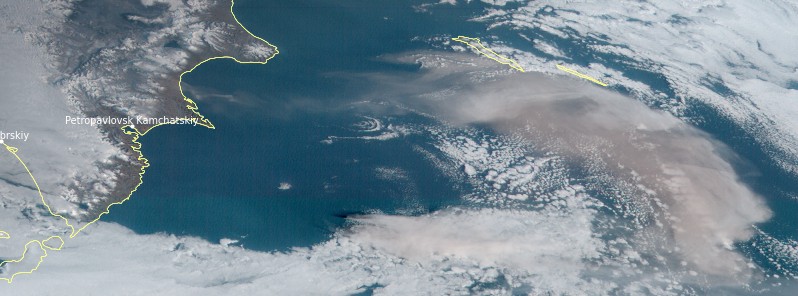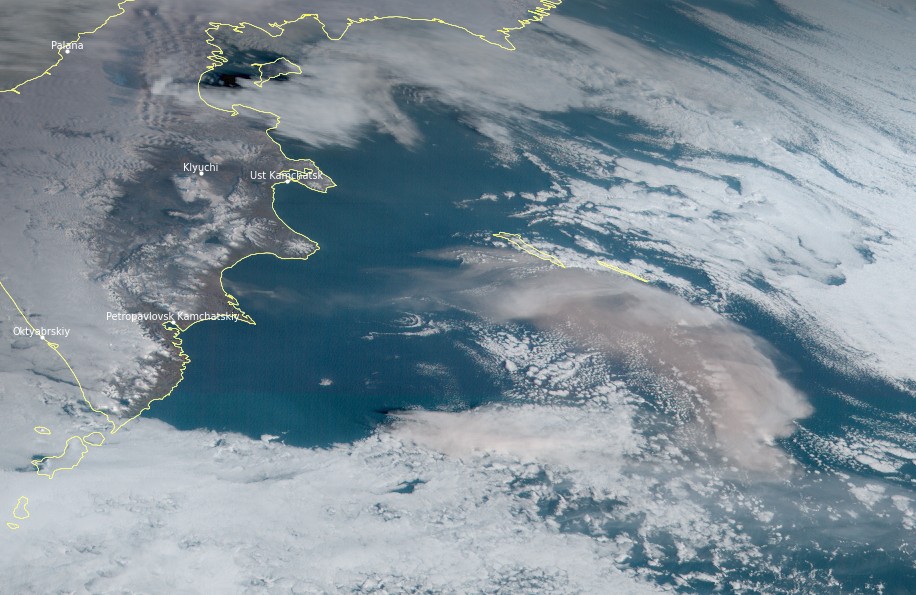Powerful explosive event at Karymsky volcano, ash up to 10.5 km (34 500 feet) a.s.l., Russia

A powerful explosive event started at the Russian Karymsky volcano, Kamchatka at 07:30 UTC on November 3, 2021, ejecting ash up 9.5 km (31 200 feet) and then up to 10.5 km (34 500 feet) above sea level. The Aviation Color Code remains at Orange.
Satellite data acquired at 21:45 UTC showed a 550 x 130 km (341 x 80 miles) ash cloud at a distance of 625 km (388 miles) southeast of the volcano.1
By 06:33 UTC on November 4, two large ash clouds 400 x 560 km (248 x 348 miles) and 280 x 80 km (174 x 50 miles) in size continued to move for 1 090 km (677 miles) and 460 km (286 miles), respectively, to the east and southeast of the volcano.2
The ash cloud stretched for 2 250 km (1 400 miles) by 23:51 UTC on November 4, with the frontal eastern part moving further to the east, and the western part – to the northeast of the volcano.3
A moderate eruptive activity of the volcano continues, KVERT said, adding that ash explosions up to 7 – 8 km (23 000 -26 200 feet) a.s.l. could occur at any time.
Ongoing activity could affect international and low-flying aircraft.

Image credit: JMA/Himawari-8, RAMMB/CIRA, TW. Acquired at 22:30 UTC on November 3, 2021
On October 22 and from October 26 to 28, explosions at Karymsky generated ash plumes that rose as high as 4 km (13 100 feet) a.s.l. and drifted 65 km (40 miles) E and SE. A thermal anomaly was visible on October 22 and 28.4
Geological summary
Karymsky, the most active volcano of Kamchatka's eastern volcanic zone, is a symmetrical stratovolcano constructed within a 5 km (3.1 miles) wide caldera that formed during the early Holocene.
The caldera cuts the south side of the Pleistocene Dvor volcano and is located outside the north margin of the large mid-Pleistocene Polovinka caldera, which contains the smaller Akademia Nauk and Odnoboky calderas.
Most seismicity preceding Karymsky eruptions originated beneath Akademia Nauk caldera, located immediately south.
The caldera enclosing Karymsky formed about 7 600 – 7 700 radiocarbon years ago; construction of the stratovolcano began about 2 000 years later. The latest eruptive period began about 500 years ago, following a 2 300-year quiescence.
Much of the cone is mantled by lava flows less than 200 years old. Historical eruptions have been vulcanian or vulcanian-strombolian with moderate explosive activity and occasional lava flows from the summit crater.5
References:
1 VONA/KVERT Information Release, November 04, 2021. KVERT, Institute of Volcanology and Seismology FEB RAS
2 VONA/KVERT Information Release, November 03, 2021. KVERT, Institute of Volcanology and Seismology FEB RAS
3 VONA/KVERT Weekly Release, November 04, 2021. KVERT, Institute of Volcanology and Seismology FEB RAS
4 Smithsonian / US Geological Survey Weekly Volcanic Activity Report, 27 October-2 November 2021 Managing Editor: Sally Kuhn Sennert
5 Karymsky – Geological summary – GVP
Featured image credit: JMA/Himawari-8, RAMMB/CIRA, TW. Acquired at 22:30 UTC on November 3, 2021

Commenting rules and guidelines
We value the thoughts and opinions of our readers and welcome healthy discussions on our website. In order to maintain a respectful and positive community, we ask that all commenters follow these rules.